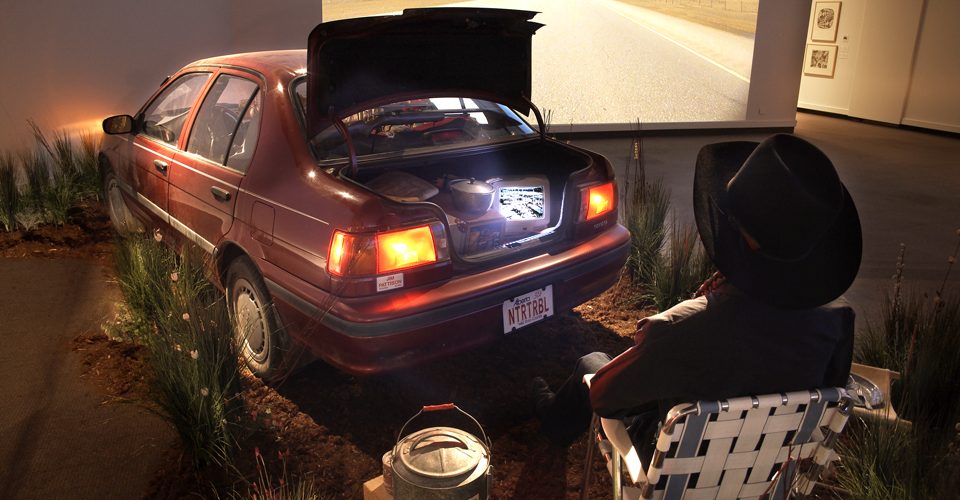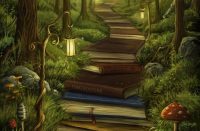Kent Monkman is no stranger to poking fun at us. That’s not to say he’s a First Nations artist who mocks the white man, or a gay person taking heterosexuals to task. No, he pokes fun at us, writ large. The part-Cree, part-Irish artist’s work includes the exploits of his alter ego, Miss Chief Eagle Testickle, in paintings and videos. His large-scale mockeries of historical scenic paintings depict decidedly sinful goings on between wild natives and the civilized white man. His teepees are glittery. His wit is sharp.
Kent Monkman is no stranger to poking fun at us. That’s not to say he’s a First Nations artist who mocks the white man, or a gay person taking heterosexuals to task. No, he pokes fun at us, writ large. The part-Cree, part-Irish artist’s work includes the exploits of his alter ego, Miss Chief Eagle Testickle, in paintings and videos. His large-scale mockeries of historical scenic paintings depict decidedly sinful goings on between wild natives and the civilized white man. His teepees are glittery. His wit is sharp.
Monkman’s latest installation, the largest of his career, takes aim at the Calgary Stampede. But the outcome is surprising. Walking through the grounds during last year’s centennial celebration and contemplating this commission from Calgary’s Glenbow Museum, the Toronto-based artist was struck by the notions of mobility and incarceration. “In a way, the Stampede was this moment that liberated First Nations people to get off the reserve and participate,” says Monkman. “In many ways, it functioned as a very positive thing.”
The Stampede’s founder and its financial backers (The Big Four) insisted that the local First Nations tribes be included in the first Stampede in 1912, but had to exert considerable political influence to make it happen. At the time, Canada’s First Nations were incarcerated on their reserves.
Using this historical separation as a starting point, Monkman’s The Big Four is a typically playful reflection on incarceration and freedom, but also on the representation of First Nations people in institutions like Glenbow.
The main thrust of the installation is four clunker vehicles, the sort you find littered about on many Canadian reservations. Often mocked, these rusted hulks are important components of contemporary native society. They can be shelter. They can be spare parts. Most importantly, however, they represent mobility and the subsequent ability to earn.
But this wouldn’t be a Monkman show if it were that straightforward. Each car (a minivan, a pickup truck and two sedans) is its own vignette, depicting some aspect of First Nations life and cheekily taking on the typical scene found in museums. There’s the woman sitting in the back of the minivan selling clothing and beads; the cowboy loading gear into his pickup with sparkly jewelry slipping out from under his shirt; the spectator watching TV in the trunk of his little car; and the troublemaker, behind the wheel and fleeing with few possessions. Each character bears Monkman’s face, a direct critique of the tendency by museums to feature one face for many cultures and different genders.
Encased in the cars are objects, including some from the Glenbow collection, which add to the scene — clothing, old Stampede banners, saddles and mock reproductions of passes from the old Indian Affairs Department, including information on how each character will spend their reparations (“Miss Chief intends to spend her treaty money on a Louis Vuitton Bag”).
Projected onto the gallery’s four walls, video of open prairie roads and flights from prairie prisons — a nod to the change in venue for incarcerated First Nations in Canada — give the cars a sense of motion. The feeling of being enclosed by the projections while taking in the show adds to the contradiction of freedom and incarceration. You feel penned in by scenes of escape.
The Big Four represents both the change and the consistency of life for First Nations in Canada. It’s about mobility, sure, but it’s also a mirror. What’s reflected is the reality that 101 years after the Stampede’s Guy Weadick and The Big Four managed to get a pass for First Nation involvement, incarceration and inequality in Canada’s Indigenous communities continues largely unabated.
The Big Four, Kent Monkman. Glenbow Museum, May 25 to August 18, 2013
This review originally appeared in Food & Drink, Issue 39.4. Subscribe now to get more reviews in your mailbox!
Reviewer Information
Drew Anderson is editor of Fast Forward Weekly in Calgary.













